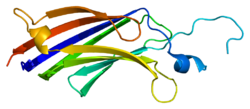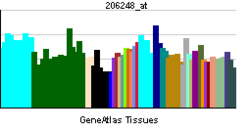- PRKCE
-
Protein kinase C epsilon type is an enzyme that in humans is encoded by the PRKCE gene.[1][2]
Contents
Function
Protein kinase C (PKC) is a family of serine- and threonine-specific protein kinases that can be activated by calcium and the second messenger diacylglycerol. PKC family members phosphorylate a wide variety of protein targets and are known to be involved in diverse cellular signaling pathways. PKC family members also serve as major receptors for phorbol esters, a class of tumor promoters. Each member of the PKC family has a specific expression profile and is believed to play a distinct role in cells. The protein encoded by this gene is one of the PKC family members. This kinase has been shown to be involved in many different cellular functions, such as apoptosis, cardioprotection from ischemia, heat shock response, as well as insulin exocytosis.
Clinical significance
Knockout and molecular studies in mice suggest that this kinase is important for regulating behavioural response to morphine[3] and alcohol.[4] [5]. It also plays a role lipopolysaccharide (LPS)-mediated signaling in activated macrophages and in controlling anxiety-like behavior.[6]
Interactions
PRKCE has been shown to interact with Cystic fibrosis transmembrane conductance regulator,[7] VDAC1,[8] COPB2,[9] Keratin 1,[9] YWHAZ,[10] MYH9,[9] Actin, alpha 1[9] and GNB2L1.[7]
See also
References
- ^ Basta P, Strickland MB, Holmes W, Loomis CR, Ballas LM, Burns DJ (Nov 1992). "Sequence and expression of human protein kinase C-epsilon". Biochim Biophys Acta 1132 (2): 154–60. PMID 1382605.
- ^ Lehel C, Olah Z, Jakab G, Anderson WB (Apr 1995). "Protein kinase C epsilon is localized to the Golgi via its zinc-finger domain and modulates Golgi function". Proc Natl Acad Sci U S A 92 (5): 1406–10. doi:10.1073/pnas.92.5.1406. PMC 42528. PMID 7877991. http://www.pubmedcentral.nih.gov/articlerender.fcgi?tool=pmcentrez&artid=42528.
- ^ Newton PM, Kim JA, McGeehan AJ, Paredes JP, Chu K, Wallace MJ, Roberts AJ, Hodge CW, Messing RO (June 2007). "Increased response to morphine in mice lacking protein kinase C epsilon". Genes Brain Behav. 6 (4): 329–38. doi:10.1111/j.1601-183X.2006.00261.x. PMID 16899053.
- ^ Newton PM, Messing RO (January 2006). "Intracellular signaling pathways that regulate behavioral responses to ethanol". Pharmacol. Ther. 109 (1-2): 227–37. doi:10.1016/j.pharmthera.2005.07.004. PMID 16102840.
- ^ Amygdala protein kinase C epsilon controls alcohol consumption http://www3.interscience.wiley.com/journal/122210376/abstract
- ^ "Entrez Gene: PRKCE protein kinase C, epsilon". http://www.ncbi.nlm.nih.gov/sites/entrez?Db=gene&Cmd=ShowDetailView&TermToSearch=5581.
- ^ a b Liedtke, Carole M; Yun C H Chris, Kyle Nicole, Wang Dandan (Jun. 2002). "Protein kinase C epsilon-dependent regulation of cystic fibrosis transmembrane regulator involves binding to a receptor for activated C kinase (RACK1) and RACK1 binding to Na+/H+ exchange regulatory factor". J. Biol. Chem. (United States) 277 (25): 22925–33. doi:10.1074/jbc.M201917200. ISSN 0021-9258. PMID 11956211.
- ^ Baines, Christopher P; Song Chang-Xu, Zheng Yu-Ting, Wang Guang-Wu, Zhang Jun, Wang Ou-Li, Guo Yiru, Bolli Roberto, Cardwell Ernest M, Ping Peipei (May. 2003). "Protein kinase Cepsilon interacts with and inhibits the permeability transition pore in cardiac mitochondria". Circ. Res. (United States) 92 (8): 873–80. doi:10.1161/01.RES.0000069215.36389.8D. PMID 12663490.
- ^ a b c d England, Karen; Ashford David, Kidd Daniel, Rumsby Martin (Jun. 2002). "PKC epsilon is associated with myosin IIA and actin in fibroblasts". Cell. Signal. (England) 14 (6): 529–36. doi:10.1016/S0898-6568(01)00277-7. ISSN 0898-6568. PMID 11897493.
- ^ Gannon-Murakami, Laura; Murakami Kentaro (Jun. 2002). "Selective association of protein kinase C with 14-3-3 zeta in neuronally differentiated PC12 Cells. Stimulatory and inhibitory effect of 14-3-3 zeta in vivo". J. Biol. Chem. (United States) 277 (26): 23116–22. doi:10.1074/jbc.M201478200. ISSN 0021-9258. PMID 11950841.
Further reading
- Slater SJ, Ho C, Stubbs CD (2003). "The use of fluorescent phorbol esters in studies of protein kinase C-membrane interactions.". Chem. Phys. Lipids 116 (1-2): 75–91. doi:10.1016/S0009-3084(02)00021-X. PMID 12093536.
- Aksoy E, Goldman M, Willems F (2004). "Protein kinase C epsilon: a new target to control inflammation and immune-mediated disorders.". Int. J. Biochem. Cell Biol. 36 (2): 183–8. doi:10.1016/S1357-2725(03)00210-3. PMID 14643884.
- Tolstrup M, Ostergaard L, Laursen AL, et al. (2004). "HIV/SIV escape from immune surveillance: focus on Nef.". Curr. HIV Res. 2 (2): 141–51. doi:10.2174/1570162043484924. PMID 15078178.
PDB gallery Kinases: Serine/threonine-specific protein kinases (EC 2.7.11-12) Serine/threonine-specific protein kinases (EC 2.7.11.1-EC 2.7.11.20) Non-specific serine/threonine protein kinases (EC 2.7.11.1)Pyruvate dehydrogenase kinase (EC 2.7.11.2)Dephospho-(reductase kinase) kinase (EC 2.7.11.3)(isocitrate dehydrogenase (NADP+)) kinase (EC 2.7.11.5)(tyrosine 3-monooxygenase) kinase (EC 2.7.11.6)Myosin-heavy-chain kinase (EC 2.7.11.7)Fas-activated serine/threonine kinase (EC 2.7.11.8)Goodpasture-antigen-binding protein kinase (EC 2.7.11.9)-IκB kinase (EC 2.7.11.10)cAMP-dependent protein kinase (EC 2.7.11.11)cGMP-dependent protein kinase (EC 2.7.11.12)Protein kinase C (EC 2.7.11.13)Rhodopsin kinase (EC 2.7.11.14)Beta adrenergic receptor kinase (EC 2.7.11.15)G-protein coupled receptor kinases (EC 2.7.11.16)Ca2+/calmodulin-dependent (EC 2.7.11.17)BRSK2, CAMK1, CAMK2A, CAMK2B, CAMK2D, CAMK2G, CAMK4, MLCK, CASK, CHEK1, CHEK2, DAPK1, DAPK2, DAPK3, STK11, MAPKAPK2, MAPKAPK3, MAPKAPK5, MARK1, MARK2, MARK3, MARK4, MELK, MKNK1, MKNK2, NUAK1, NUAK2, OBSCN, PASK, PHKG1, PHKG2, PIM1, PIM2, PKD1, PRKD2, PRKD3, PSKH1, SNF1LK2, KIAA0999, STK40, SNF1LK, SNRK, SPEG, TSSK2, Kalirin, TRIB1, TRIB2, TRIB3, TRIO, Titin, DCLK1Myosin light-chain kinase (EC 2.7.11.18)MYLK, MYLK2, MYLK3, MYLK4Phosphorylase kinase (EC 2.7.11.19)Elongation factor 2 kinase (EC 2.7.11.20)Serine/threonine-specific protein kinases (EC 2.7.11.21-EC 2.7.11.30) Polo kinase (EC 2.7.11.21)Cyclin-dependent kinase (EC 2.7.11.22)(RNA-polymerase)-subunit kinase (EC 2.7.11.23)Mitogen-activated protein kinase (EC 2.7.11.24)Extracellular signal-regulated (MAPK1, MAPK3, MAPK4, MAPK6, MAPK7, MAPK12, MAPK15), C-Jun N-terminal (MAPK8, MAPK9, MAPK10), P38 mitogen-activated protein (MAPK11, MAPK13, MAPK14)MAP3K (EC 2.7.11.25)Tau-protein kinase (EC 2.7.11.26)(acetyl-CoA carboxylase) kinase (EC 2.7.11.27)-Tropomyosin kinase (EC 2.7.11.28)-Low-density-lipoprotein receptor kinase (EC 2.7.11.29)-Receptor protein serine/threonine kinase (EC 2.7.11.30)Dual-specificity kinases (EC 2.7.12) Categories:- Human proteins
- Chromosome 2 gene stubs
- Cell signaling
- Signal transduction
Wikimedia Foundation. 2010.



